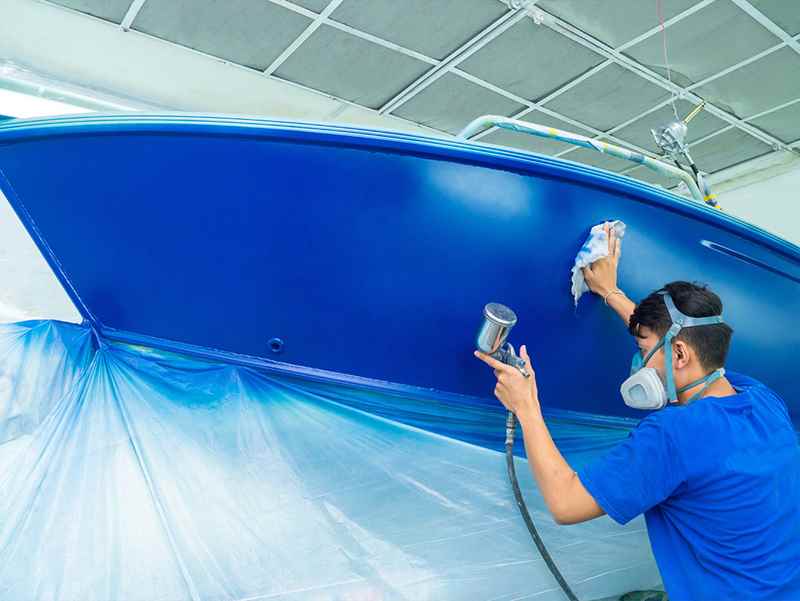Table of Contents
Understanding Boat Upholstery
Imagine gliding across the water, with the wind in your hair and the sun on your face. Now, think about where you’re sitting. That’s right, the upholstery! It’s not just about comfort. It’s about a part of the boat that endures a lot of wear and tear, yet often gets overlooked. So what goes into this essential boat element?
Boat Upholstery Materials
When selecting boat upholstery materials, two popular choices stand out: marine vinyl and durable PVC vinyl. Marine vinyl is a top pick due to its ability to resist moisture, UV rays, and mildew. Its durability ensures that it can withstand the harsh marine environment while providing a comfortable seating surface. On the other hand, PVC vinyl offers similar benefits and is known for its toughness, often used in areas that require extra resilience. Understanding the distinct properties of these materials is crucial for making informed decisions about boat maintenance and aesthetics.
Importance of Proper Maintenance on Boat Upholstery
Moving on, let’s tackle the importance of proper maintenance for the longevity of boat seats and upholstery fabric. Regular care doesn’t just keep the boat looking great. It also extends the life of the upholstery. The marine environment can be brutal, with saltwater, sunlight, and fluctuating temperatures all having the potential to cause damage. By maintaining your upholstery, you’re not only preserving its appearance but also ensuring its structural integrity over time. This means less frequent replacements and more savings in the long run.
Quality and Price of Seaquest Marine Upholstery Vinyl
Lastly, an overview of the original price and quality of Seaquest Marine upholstery vinyl can guide buyers toward a worthwhile investment. Seaquest is known for its premium quality marine grade vinyl that comes at a competitive price, balancing cost-effectiveness with superior performance. You can view fabric with a variety of designs and colors here. It’s designed to be tough against the elements, resistant to fading, and easy to clean. While initial costs might be higher compared to standard materials, the durability and extended lifespan of Seaquest Marine vinyl offer long-term value, potentially reducing the frequency and cost of replacements. You can find these products on Amazon.
Cleaning Boat Upholstery
Embarking on the journey of cleaning your boat upholstery requires more than just elbow grease. It demands smart techniques and the right products to ensure your efforts contribute to the longevity and freshness of your marine vinyl and upholstery fabric. Let’s dive into effective cleaning practices that keep your boat seats looking as inviting as the sea itself.
Effective Cleaning Techniques for Marine Vinyl and Upholstery Fabric
Marine vinyl, with its sturdy build, faces the brunt of the elements, and thus, regular cleaning is not just a choice, but a necessity.
Begin with a soft-bristle brush or a clean cloth to whisk away loose dirt and debris. Follow this up with a gentle, soapy solution. Mild dish soap mixed in warm water works wonders. Use a circular motion to work the solution into the fabric, paying attention to crevices where dirt loves to hide. Afterward, rinse thoroughly with clean water to remove any soap residue. This step is crucial as leftover soap can attract more dirt over time. Always finish by drying the area completely with a soft towel to prevent mildew growth, which thrives in damp conditions. It’s important to focus on seams on marine upholstery when cleaning.
Use of Appropriate Cleaning Products to Preserve the Quality of Boat Upholstery
The market floods with cleaning products claiming to be the panacea for all your boat upholstery woes. However, the key is to use cleaners specifically designed for marine vinyl and upholstery fabrics. These products are formulated to tackle the unique challenges of the marine environment without causing harm to the material. When selecting a cleaner, opt for one that is non-abrasive and free of harsh chemicals like bleach and ammonia, as they can break down the fabric and cause discoloration. A pH-balanced cleaner is your best bet, ensuring you maintain the integrity of the upholstery while getting it squeaky clean.
Tips for Removing Stubborn Stains Without Damaging Boat Upholstery
Sometimes, despite our best efforts, stains seem to cling on for dear life. A specialized stain remover for marine fabrics can be your ally for these stubborn cases. Before applying, always spot-test in an inconspicuous area to ensure there’s no adverse reaction.
Gently apply the stain remover, let it sit for the recommended amount of time, and then softly scrub away. For organic stains, like those from food or drinks, a mixture of vinegar and water can be used. In contrast, for mold and mildew, a blend of water and hydrogen peroxide may do the trick. Remember, patience is a virtue when dealing with tough stains—repeated, gentle treatments are preferable to a single aggressive scrub, which could harm the fabric.
Implementing these strategies will not only keep your boat’s interior pristine but also enhance the overall boating experience. By maintaining the cleanliness and integrity of your boat upholstery, you’re setting sail for years of enjoyment on the water.
Maintaining Boat Upholstery
Now that we’ve tackled the art of cleaning your boat’s upholstery, let’s dive into the nitty-gritty of keeping it in tip-top shape. Regular maintenance isn’t just a good habit—it’s the anchor that keeps the beauty and functionality of your boat seats from drifting away due to wear and tear. But what exactly does this entail?
Best Practices to Prevent Deterioration Boat Upholstery
To prevent the deterioration of your boat upholstery, a proactive approach is key. First, make it a routine to rinse off your seats with fresh water after each outing, especially if you’ve been in saltwater. Salt can be corrosive, and even though marine-grade materials are designed to withstand harsh conditions, they’re not indestructible. After a quick rinse, dry the upholstery thoroughly to prevent mold and mildew from setting up camp.
In addition to rinsing, regular conditioning is crucial. Use a conditioner designed for marine upholstery. It will help keep the vinyl supple and prevent cracking. Apply it gently with a soft cloth, ensuring even coverage without over-saturating the material. And remember, always read the product instructions to avoid misuse that could lead to damage.
Protecting Boat Seats from Sun Exposure and Other Environmental Factors
The sun’s ultraviolet rays can be as harmful to your boat seats as they are to your skin. Continuous exposure to sunlight can cause the color of your upholstery to fade and the material to weaken over time. To shield your seats from the sun, consider using a UV protectant spray after cleaning and conditioning. This acts like sunscreen for your seats, offering an additional layer of defense against the harsh rays.
Moreover, when your boat isn’t in use, cover it! A boat cover not only keeps your upholstery clean but also minimizes exposure to environmental factors such as rain, bird droppings, and tree sap, all of which can be surprisingly abrasive. If you dock your boat, look into canopy systems or covered moorage options for extra protection.
Importance of Using Marine-Grade Products for Long-Term Durability
Just as you wouldn’t bring a knife to a gunfight, you shouldn’t bring household cleaners to a boat maintenance routine. The importance of using marine-grade products for your boat’s upholstery cannot be overstated. These products are specifically formulated to handle the rigors of the aquatic environment—resisting water, preventing mold, and combating UV damage.
Invest in cleaners, conditioners, and protectants that are labeled as suitable for marine use. While they might come with a slightly higher price tag than their household counterparts, they’re a worthwhile investment for the lifespan of your boat’s interior. Think of them as the guardians of your boat upholstery, warding off premature aging and maintaining the material’s integrity.
By following these best practices for maintenance, you’re not just preserving the appearance of your boat. You’re safeguarding the investment and the countless memories you’ll make aboard. Implementing a thorough maintenance regime will ensure that your boat remains a source of pride and joy for many seasons to come.
Why Regular Maintenance is Essential
Let’s delve into the potential consequences of neglecting boat upholstery maintenance. Imagine setting sail on a beautiful sunny day, only to find that your boat’s seats have lost their vibrant color, the material has cracked, and there’s a musty odor wafting from the corners. This scenario is not just unpleasant. It’s a direct result of inadequate care for your boat’s interior. UV rays are notorious for causing fading in fabrics, while constant exposure to moisture can lead to cracking in less resilient materials such as vinyl. Furthermore, the humid marine environment is a breeding ground for mold and mildew growth, which not only deteriorates the upholstery but can also pose health risks.
The Costs of Neglect
Proper maintenance does more than keep boat upholstery looking good. It also saves time and money in the long run. When the fabric or material begins to degrade, it’s not just an eyesore—it can become functionally compromised. Tears and weak spots may develop, leading to the need for costly repairs or even complete replacement. By regularly cleaning and treating your upholstery, you’re effectively putting a barrier between the elements and the fabric, thereby extending its lifespan and ensuring that your investment remains intact for years to come.
Maintaining Aesthetic Appeal and Comfort
Beyond the financial implications, regular maintenance plays a critical role in preserving the aesthetic appeal and comfort of your boat’s interior. The visual aspect of well-kept upholstery contributes to the overall boating experience and can be a point of pride when entertaining guests. Comfort, too, is key—no one enjoys sitting on cracked or sticky seats. Through consistent care, including cleaning and conditioning, your boat’s upholstery remains welcoming and enjoyable for everyone on board.
To conclude, think of your boat’s upholstery as the face of your vessel—it’s one of the first things people notice when they step aboard. Regular maintenance isn’t just a chore. It’s an investment in the longevity, beauty, and functionality of your boat. As we look ahead to best practices for cleaning and long-term maintenance tips, remember that prevention is always better than cure. By taking proactive steps today, you can avoid the headaches of extensive repairs tomorrow.
Conclusion: Ensuring a Long Life for Boat Upholstery
Having explored the various facets of boat upholstery care, let’s revisit the essentials that can keep your boat’s interior looking its best. Remember, the longevity of your marine seating is largely dependent on the attention you give to regular maintenance. This not only enhances the visual appeal of your boat but also reinforces the functionality and comfort of your onboard experiences.
Recap of Key Maintenance Strategies for Boat Upholstery
Key strategies play a pivotal role in the preservation of your boat’s upholstery. Consistent cleaning after outings helps prevent the accumulation of salts and pollutants that can degrade fabric quality. Applying marine-grade conditioners is not just a good practice—it’s a necessary step to ward off the harsh effects of UV rays and prevent cracking or fading. Furthermore, safeguarding your seats from environmental factors, such as covering them when not in use, extends their life and keeps them looking new.
Emphasizing the Value of Investing in High-Quality Marine Vinyl and Upholstery Fabric
While maintenance is crucial, the foundation of long-lasting upholstery lies in the quality of the materials used. High-quality marine vinyl and upholstery fabrics are designed to withstand the rigors of the marine environment. They resist mold, mildew, and UV damage more effectively than standard fabrics, making them a wise investment for any boat owner. Investing in these materials may come at a higher initial cost, but their durability translates into cost savings over time, as they require less frequent replacement.
Encouraging Readers to Implement the Tips for Prolonged Enjoyment of Their Boat’s Interior
We’ve laid out a clear path to maintaining your boat’s upholstery, but it’s up to you to walk it. Integrating these tips into your routine can transform the task from a chore into an act of pride for your vessel. Whether it’s through the diligent application of protectants or the careful selection of cleaning products, your efforts will pay dividends in the form of a beautiful and enduring boat interior. So, take the helm of upholstery care and steer your boat’s aesthetic toward uncharted levels of excellence.

















